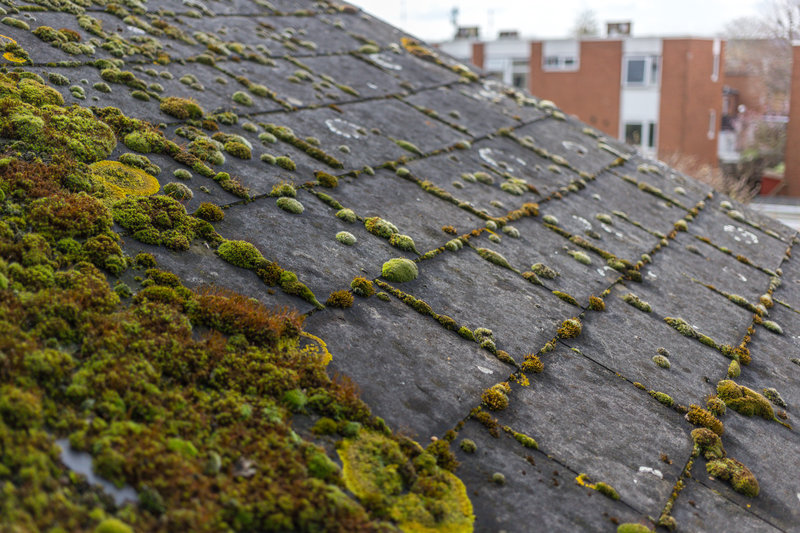
In addition to potential roof damage requiring repair or replacement, roof algae diminish curb appeal and can negatively impact utility spending. Once you’ve identified your roof is affected by algae, your best bet is to call a professional.
In addition to safely cleaning and removing the algae – using a safe combination of agents that make the roof less inviting for future colonies– a professional roof contractor’s expert cleaning and maintenance prevents further roof damage from occurring.
Signs Of Roof Algae (And Fungus)
Black spots, or delta’s of migrating black trails, are the most telltale signs your roof is growing algae. The algae arrive on your roof via spores, typically falling from the trees above or from spores carried in rainwater or fog.
They prefer a specific climate – one that is moist gets minimal to dappled sunlight and warms up from time to time. If your roof hasn’t been affected yet, you may notice roof algae tends to proliferate on north-facing roofs – which tend to have more moisture and dappled sunlight. They can feed on numerous organic compounds, and once the spores have anchored themselves in the shingles of your roof, they begin to break down some of the roof’s structural components.
Raise the red flag the minute you notice signs of algae growth because the longer the algae is left undisturbed, the more damage it will do. Algae is typically the “first arrival” on the scene. Once established, they are the ideal host for fungus and other organisms, leading to the growth of lichen, moss, and other harmful roof organisms.
Side Effects Of Algae-Infested Roofs
In addition to being unsightly, algae slowly break down certain roofing material, leading to structural damage. Over time, the negative impacts of algae include:
- Increased solar heat gain. Roof algae are black as the result of a pigment that acts as the algae’s “sunscreen.” Unfortunately for your home, this black coating absorbs more sunlight, heating the attic and increasing your home’s overall solar heat gain. This is particularly noticeable during the summer months.
- Increased energy spending. As a result of that solar heat gain, you may notice your HVAC works harder to maintain comfortable interior temperatures, resulting in higher energy bills. This is especially apparent in upper-stories that are closer to the attic. If algae continue to grow year after year, you’ll experience an increase in your HVAC repair costs due to increased wear-and-tear.
- Structural damage leading to leaks and repairs. If left too long, the algae eventually break down structural components, causing leaks and excess moisture accumulation in the home. Ultimately, this results in unnecessary roof repairs or even replacement.
In all cases, routine cleaning and maintenance prevent roof algae from ever becoming a serious concern.
Take Precaution When Cleaning And Eradicating Algae From Your Roof
Homeowners can wind up doing more harm than good when trying to eradicate algae from their roof.
Safety is always the first priority
Safety is the Number One reason to leave roof algae removal to the professionals. It can be slippery work, and you’re performing at dangerous heights. If you’re tackling it as a DIY job – make sure you have:
- Stable ladder
- Safety rope
- Slip-resistant shoes
- Rubber gloves
- Safety goggles
Read our, Ultimate Guide to Roofing Safety before proceeding.
Don’t use a pressure washer on asphalt shingles
Time and time again, we’ve been called out to perform roof maintenance or shingle repairs after a homeowner used a pressure washer to clean their roof or remove roof algae and/or moss. Pressure washers compromise the integrity of most asphalt shingle products. Algae only require a low-pressure wash to become dislodged from the surface.
Use a gentle solution mixed with water to clean off roof algae
A mild combination of bleach and water (1 part bleach, 4 parts water), is typically enough to do the trick. If you want a more eco-friendly option, your local hardware or home improvement center has additional options. Oxygen bleach solutions are also effective but are typically more temporary than chlorine bleach solutions.
Once the roof is completely clean, consider installing a copper- or zinc-coated sheet metal, under the ridge, on each side of the roof. At least two- to four inches of the metal strip should be visible. Copper and zinc are toxic to roof algae and help to prohibit future growth. Galvanized metal is also a desirable option since it’s less expensive, but it’s not as effective as copper- or zinc-coated materials.
Let Us Clean It For You
Worried about signs of roof algae on your Bay Area roof? If you don’t want to do-it-yourself we can do it for you. Contact us here at Pacific Coast Roofing.

